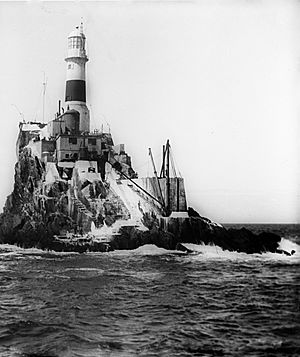Fastnet Lighthouse facts for kids
| Tower shape | Tapered cylindrical tower with lantern and double gallery |
|---|---|
| Ireland number | CIL-0010 |
The Fastnet Lighthouse is a tall lighthouse, about 54 meters (177 feet) high. It stands on a remote spot called Fastnet Rock in the Atlantic Ocean. This rock is the most southerly point of Ireland. It is about 6.5 kilometers (4 miles) southwest of Cape Clear Island and 13 kilometers (8 miles) from County Cork on the Irish mainland. The lighthouse you see today is the second one built on the rock, and it is the tallest lighthouse in Ireland.
The First Fastnet Lighthouse
Work on the first lighthouse began in 1853. It first shone its light on January 1, 1854. This lighthouse was built to replace an older one on Cape Clear Island. A big reason for building it was a terrible shipwreck in 1847. A ship called Stephen Whitney crashed in thick fog near West Calf Island. Sadly, 92 out of 110 people on board died.
The first lighthouse was made of cast iron with bricks inside. George Halpin designed it. It cost £17,390 to build. The tower was about 63 feet 9 inches (19.4 meters) tall. On top was a lantern structure, making the total height around 91 feet (28 meters). It used an oil lamp that was not very bright compared to modern lights.
This first tower was not strong enough. Strong winds would shake it so much that things would fall off tables. Once, a large barrel of water tied to the top gallery was washed away by the sea. To make it stronger, workers added a casing around the bottom part and filled it with stone. In 1865, the lower floors were filled with solid material.
The Second Fastnet Lighthouse
In 1891, the Commissioners of Irish Lights decided the light was not powerful enough. This was especially important because it was often the first landmark ships saw when crossing the Atlantic Ocean. They decided to build a new lighthouse out of stone. Cast iron was no longer considered safe because another nearby tower had been swept away by a storm in 1881.
The new lighthouse was designed by William Douglass. James Kavanagh oversaw its construction. Building started in 1897 by leveling the site. The first of 2,047 special Cornish granite blocks was laid in June 1899. These blocks weighed 4,300 tons in total. A small steamship, the Ierne, was built just to carry these heavy blocks to the island. James Kavanagh personally placed every stone. The new lighthouse started working on June 27, 1904, and cost almost £90,000.
The stone tower is 146 feet (44.5 meters) high. The light itself shines from 159 feet (48.5 meters) above the high-water mark. The base of the lighthouse is 52 feet (15.8 meters) wide. The first ten of its 89 stone layers are built right into the rock. Part of the first tower was left behind and is now used as an oil storage room.
In 1969, the old paraffin light was replaced with an electric one. In 1989, the lighthouse became automatic. This means people no longer need to live there to operate it. It is now controlled remotely from a center in Dún Laoghaire.
The light flashes white for 0.14 seconds every five seconds. It can be seen from about 27 nautical miles (50 kilometers) away. Since 1978, the light also operates during poor visibility, not just at night. The old explosive fog signal was replaced in 1974 with an electric fog horn. This horn made four blasts every minute. However, the fog signal was permanently turned off on January 11, 2011. A Racon (a radar beacon) has been in place since 1994, showing a Morse G on ship radars.
In 1985, a huge rogue wave about 157 feet (48 meters) high hit the lighthouse. On October 16, 2017, during Hurricane Ophelia, a wind gust of 191 kilometers per hour (119 miles per hour) was recorded at the lighthouse. This is the strongest wind ever recorded in Ireland since the 1860s!
Fastnet Rock
Fastnet Rock is also known as Carraig Aonair, which means "lonely rock" in Irish. It is a small island made of clay-slate with shiny quartz veins. It rises about 30 meters (98 feet) above the low water mark. A small channel, about 10 meters (33 feet) wide, separates it from the even smaller Little Fastnet to the south.
Fastnet Rock is sometimes called "Ireland's Teardrop." This is because it was the last piece of Ireland that many Irish people saw in the 1800s as they sailed away to North America.
The Fastnet Rock also gives its name to a sea area used by the Shipping Forecasts. These are weather reports broadcast by the BBC for ships.
The rock is also a key point in one of the world's most famous offshore yacht races, the Fastnet Race. This race is about 1126 kilometers (700 miles) long. It starts from Cowes on the Isle of Wight, goes around Fastnet Rock, and then returns to Plymouth. It is also used as a marker for shorter yacht races from nearby sailing towns like Schull, Baltimore, and Crookhaven.
Images for kids
-
Dovetail granite blocks are visible during the early foundation construction. This image was published in Scientific American.




